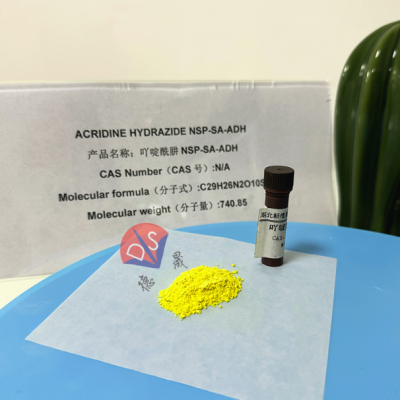Home > Products > Chemiluminescence reagent > The labeling principle and application of acridine hydrazide NSP-SA-ADH
The labeling principle and application of acridine hydrazide NSP-SA-ADH
≥10 Milligrams
- Shanghai
- T/T L/C
- 5 days
You May Like
-
Application and pH stability of acetyl CoA oxidase
-
Tris and glutamate dehydrogenase work together on homocysteine assay kit
-
The relationship between purine nucleoside phosphorylase and nucleic acid synthesis and decomposition
-
Introduction of Desheng on Alpha Glucosidase
-
Glucose dehydrogenase: a key enzyme in IVD in vitro diagnostic reagents
-
Detailed explanation of storage methods for adenosine deaminase (ADA)
Product Details
| Application | Scientific Research | Usage | Laboratory Reagents, Analytical Reagents, Diagnostic Reagents | |
| Property | Biochemical Reagent | Classification | High Purity Material | |
| Grade | AR |
Product Description
In the fields of chemistry and biology, chemiluminescence technology has become a powerful assistant for researchers due to its high sensitivity, fast response, and no need for external light sources. Among them, acridine hydrazide NSP-SA-ADH, as a chemiluminescence reagent, is attracting increasing attention due to its unique labeling principle and wide application prospects.
The labeling principle of acridine hydrazide NSP-SA-ADH
Acrylamide hydrazide NSP-SA-ADH is a fluorescent label based on the acridine structure, which endows it with excellent fluorescence performance and biocompatibility due to its chemical structure. During the labeling process, NSP-SA-ADH binds to biomolecules (such as proteins, nucleic acids, etc.) through specific chemical reactions, forming stable fluorescent complexes. This binding method ensures the fluorescence characteristics of the marker while avoiding interference with the function of biomolecules.
Specifically, the labeling principle of NSP-SA-ADHD mainly includes the following steps:
1. Selecting target biomolecules: Researchers need to choose suitable biomolecules as marker objects based on their research objectives. These biomolecules can be proteins and nucleic acids within cells, as well as receptors and ion channels on the cell membrane.
2. Chemical reaction binding: Utilizing the active groups on NSP-SA-ADH to chemically react with specific functional groups on biomolecules, forming stable fluorescent complexes. This binding method has high specificity and selectivity, ensuring that the marker is accurately labeled on the target biomolecule.
3. Fluorescence signal detection: Fluorescence signals emitted by labeled biomolecules are detected using instruments such as fluorescence microscopy and flow cytometry. These fluorescent signals can reflect the position, quantity, and dynamic changes of biomolecules, providing important experimental data for researchers.
Application of Acrylaminoyl Hydrazide NSP-SA-ADH
As a novel fluorescent marker, NSP-SA-ADH has broad application prospects in the field of biological sciences. Here are several typical application cases:
1. Protein interaction research: By labeling different proteins, researchers can study the interaction relationships between them. For example, proteins labeled with NSP-SA-ADH can be used to detect the binding state between proteins through fluorescence resonance energy transfer (FRET) technology, thereby revealing the mechanism of protein interactions.
2. Cell imaging and localization: NSP-SA-ADH can be used to label specific proteins or nucleic acids within cells, achieving cell imaging and localization. This technology can help researchers observe the distribution, movement, and interactions of biomolecules within cells, providing strong support for cell biology research.
3. Disease diagnosis and treatment: In the medical field, NSP-SA-ADH can be used to label target substances such as tumor cells and pathogens, achieving early diagnosis and correct treatment of diseases. For example, by labeling specific receptors on the surface of tumor cells, researchers can develop targeted drugs that target these receptors, improving the specificity and effectiveness of treatment.
4. Drug screening and evaluation: NSP-SA-ADH can also be used for drug screening and evaluation. By labeling the target molecules of drug action, researchers can monitor the binding between drugs and target molecules in real time, evaluate the efficacy and safety of drugs.
Hubei Xindesheng Material Technology Co., Ltd. produces chemiluminescent reagents such as acridine hydrazide NSP-SA-ADH with a purity of over 98%, good water solubility, stable process, and small batch differences. They are highly trusted and recognized by users both domestically and internationally. If you have any purchasing needs in the near future, please feel free to contact me or click on the official website for more details!
Contact Us

- Hubei New Desheng Material Technology Co., Ltd
- Contact nameDoris Yang Chat Now
Product Categories
| Additive for blood collection | Biological buffer | Chemiluminescence reagent | Chromogenic substrate |
| enzyme preparation |
New Products
-
Biological functions and applications of malate dehydrogenase
-
The price of TRIS-HCL 1185-53-1 produced by Desheng has been lowered. Please feel free to consult and purchase
-
Why should we pay attention to solubility when purchasing biological buffer TRIS 77-86-1?
-
The Effect of Purity of BICINE Powder 150-25-4 as a Biological Buffer on the Performance of Buffer Solutions
-
Introduction to the transportation packaging of CAPS powder 1135-40-6, a biological buffering agent
-
Compatibility of biological buffer MOPS 1132-61-2 with other reagents
-
Application of Biological Buffer TAPS 29915-38-6 in Enzyme Activity Research
-
The advantage of high purity of EPPS powder 16052-06-5 raw materials for biological buffering agents
-
Advantages of MOPSO buffer 68399-77-9 in low-temperature biochemical work
-
What does HEPES buffer 7365-45-9 do for cell culture
-
Application of Biological Buffer PIPES 5625-37-6 in Biochemical Research
-
How to determine and choose a BES buffer 10191-18-1 manufacturer for procurement
-
Biological buffer DIPSO (68399-80-4) detailed description for quick understanding
-
Multiple applications of CHES buffer in biological research
-
Detailed functions and uses of serum separation gel
-
Sodium heparin, a specialized additive for blood glucose test tubes
-
How to detect electrolytes with lithium heparin
-
Precautions for using anticoagulant EDTA dipotassium
-
Manufacturer of blood collection tube additive EDTA tripotassium
-
Spot supply of blood coagulants
-
How to choose high-efficiency coagulant powder and coagulant suspension?
-
Factors affecting the silicification effect of water-soluble silicification agents on blood collection tubes
-
Potassium oxalate as an additive for blood collection tubes
-
Sodium citrate anticoagulant tube for coagulation testing
Popular Searches
Recommended Products
- Sodium Metasilicate Granular in detergent industrial
- STPP Sodium Metasilicate Granular in detergent industrial SMS-5H2O
- Cocamido Propyl Betaine 35% stability Factory Price
- Potato Dextrose Agar
- MacC /MacConkey Agar
- EMB Agar
- Tryptose
- Lecithin from egg yolk CAS:93685-90-6
- HSPC CAS:92128-87-5
- Casein acid CAS:65072-00-6
- Yeast extract powder
- Wheat gern powder CAS:68917-73-7
Find Similar Products By Category
- Chemicals > Chemical Reagent
- Please Enter your Email Address
- Please enter the content for your inquiry.
We will find the most reliable suppliers for you according to your description.
Send Now-
 Doris Yang
Hi there! Welcome to my shop. Let me know if you have any questions.
Doris Yang
Hi there! Welcome to my shop. Let me know if you have any questions.
Your message has exceeded the limit.

- Contact supplier for lowest price
- Customized Request
- Request Sample
- Request Free Catalogs
Your message has exceeded the limit.
-
Purchase Quantity
-
*Sourcing Details
Your inquiry content must be between 10 to 5000 characters.
-
*Email
Please enter Your valid email address.
-
Mobile






